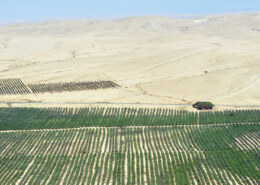Northeast India has historically received high rainfall, but recent years have seen fluctuations with intense bursts and dry periods. How can agricultural practices be adapted to cope with this changing precipitation pattern and ensure food security in the region?
To ensure sustainable agricultural practices that are resilient to climate change disruptions such as droughts and floods, several strategies can be implemented. These strategies focus on enhancing the resilience of agricultural systems, improving resource management, and fostering sustainable practRead more
To ensure sustainable agricultural practices that are resilient to climate change disruptions such as droughts and floods, several strategies can be implemented. These strategies focus on enhancing the resilience of agricultural systems, improving resource management, and fostering sustainable practices. Here are some key approaches:
1. Implementing Climate-Smart Agriculture (CSA)
Crop Diversification
- Diverse Crop Varieties: Plant a variety of crops to spread risk and ensure some yield even if certain crops fail.
- Drought- and Flood-Resistant Varieties: Use crop varieties that are specifically bred to withstand extreme weather conditions.
Agroforestry
- Integration of Trees and Crops: Plant trees alongside crops to provide shade, reduce erosion, and improve soil fertility.
- Windbreaks and Shelterbelts: Use trees and shrubs as windbreaks to protect crops from strong winds and reduce soil erosion.
2. Enhancing Soil Health and Water Management
Soil Conservation Practices
- Cover Cropping: Grow cover crops to protect soil from erosion, improve soil structure, and add organic matter.
- Conservation Tillage: Reduce tillage to maintain soil structure, enhance water retention, and reduce erosion.
Efficient Water Management
- Drip Irrigation: Implement drip irrigation systems to deliver water directly to plant roots, reducing water waste.
- Rainwater Harvesting: Collect and store rainwater for use during dry periods, ensuring a reliable water supply for crops.
- Improved Drainage Systems: Develop drainage systems to prevent waterlogging and reduce flood damage.
3. Leveraging Technology and Innovation
Precision Agriculture
- Remote Sensing and GIS: Use remote sensing and Geographic Information Systems (GIS) to monitor crop health, soil conditions, and weather patterns for better decision-making.
- Automated Systems: Employ automated irrigation and fertilization systems to optimize resource use and reduce waste.
Early Warning Systems
- Climate Forecasting: Implement early warning systems and climate forecasting tools to provide farmers with timely information on weather patterns and extreme events.
- Decision Support Systems: Develop decision support systems to help farmers make informed choices about planting, irrigation, and harvesting based on weather forecasts and climate data.
4. Building Resilient Farming Systems
Integrated Pest Management (IPM)
- Biological Controls: Use natural predators and biopesticides to manage pests and reduce reliance on chemical pesticides.
- Cultural Practices: Rotate crops and use intercropping to disrupt pest life cycles and reduce pest populations.
Sustainable Livestock Management
- Rotational Grazing: Implement rotational grazing to maintain pasture health and prevent overgrazing.
- Integrated Crop-Livestock Systems: Combine crop and livestock farming to enhance nutrient cycling and improve farm resilience.
5. Supporting Farmers and Communities
Capacity Building and Education
- Farmer Training Programs: Provide training on sustainable farming practices, climate resilience, and resource management.
- Extension Services: Strengthen agricultural extension services to offer ongoing support and advice to farmers.
Financial Support
- Access to Credit: Provide microfinance and low-interest loans to help farmers invest in climate-resilient technologies and practices.
- Insurance Programs: Develop agricultural insurance programs to protect farmers against crop losses due to extreme weather events.
6. Promoting Sustainable Practices and Policies
Policy Support
- Incentives for Sustainable Practices: Implement policies that provide incentives for adopting sustainable farming practices, such as subsidies for organic farming or conservation tillage.
- Land Tenure Security: Ensure secure land tenure rights to encourage long-term investments in sustainable agriculture.
Community-Based Approaches
- Community Gardens and Cooperative Farms: Promote community-based farming initiatives to enhance food security and resilience at the local level.
- Knowledge Sharing: Foster a culture of knowledge sharing and collective problem-solving among farmers.
7. Enhancing Research and Development
Agricultural Research
- Development of Resilient Crops: Invest in research to develop crop varieties that are resilient to extreme weather conditions and climate change.
- Innovative Farming Practices: Support research into innovative farming practices that enhance sustainability and resilience.
Climate Research
- Impact Studies: Conduct research to understand the impacts of climate change on agriculture and identify effective adaptation strategies.
- Technology Transfer: Facilitate the transfer of climate-resilient technologies and practices to farmers through extension services and training programs.
Conclusion
Ensuring sustainable agricultural practices that are resilient to climate change requires a multi-faceted approach that combines technological innovation, sustainable resource management, farmer support, and policy initiatives. By adopting these strategies, agricultural systems can become more resilient to extreme weather events, ensuring continued food production to meet the growing global demand.



Agricultural practices in Northeast India must adapt to fluctuating rainfall patterns to ensure food security. First, implementing water-efficient irrigation systems like drip and sprinkler irrigation can optimize water use during dry periods. Additionally, constructing rainwater harvesting systemsRead more
Agricultural practices in Northeast India must adapt to fluctuating rainfall patterns to ensure food security. First, implementing water-efficient irrigation systems like drip and sprinkler irrigation can optimize water use during dry periods. Additionally, constructing rainwater harvesting systems can store excess water during intense bursts for later use.
Adopting crop diversification, including drought-resistant and flood-tolerant crop varieties, can mitigate risks associated with unpredictable precipitation. Integrating agroforestry, which combines crops with tree cultivation, can improve soil moisture retention and reduce erosion.
Promoting organic farming and sustainable soil management practices, such as crop rotation and mulching, can enhance soil health and resilience to weather extremes. Farmers should also be trained in climate-resilient farming techniques through extension services and agricultural research institutions.
Community-based approaches, like forming water user associations and cooperatives, can facilitate shared resources and collective decision-making. Additionally, leveraging weather forecasting technologies and early warning systems can help farmers plan and respond to weather changes effectively.
By combining traditional knowledge with modern agricultural innovations, Northeast India can build a more resilient agricultural system capable of coping with changing precipitation patterns, ensuring sustained food production and security.
See less